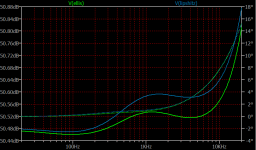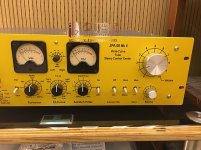Really
Last time I used differential equations and the Newton-Raphson method for valuation solving it was for sinking fund bonds, and securities of companies in bankruptcy. Turns out that no such precision is necessary or warranted! That was decades ago.
John Ellis, writing in December 2022 AudioXpress proposes an iterative method of solving for the R and C values of the RIAA network which is more precise than Lipshitz's "1A" configuration. This allows for incorporating the value of the "ground resistor" (Rg?) in a conventional feedback RIAA network.
The chart below summarizes the results of his proposed values with those which would be derived from Lipshitz using a very simple op-amp circuit. The difference at 1kHz seems to be about 0.055dB
Last time I used differential equations and the Newton-Raphson method for valuation solving it was for sinking fund bonds, and securities of companies in bankruptcy. Turns out that no such precision is necessary or warranted! That was decades ago.
John Ellis, writing in December 2022 AudioXpress proposes an iterative method of solving for the R and C values of the RIAA network which is more precise than Lipshitz's "1A" configuration. This allows for incorporating the value of the "ground resistor" (Rg?) in a conventional feedback RIAA network.
The chart below summarizes the results of his proposed values with those which would be derived from Lipshitz using a very simple op-amp circuit. The difference at 1kHz seems to be about 0.055dB
Attachments
I have not read the article, but I think the design method has to be iterative.
The 75us and 3180us breaks are easy. 318us is where the difficulty lies.
Since I write software as a hobby, I wrote a program to compute the error for my pre-amplifier. I iterated using standard component values. I use passive RIAA equalization driven by a current source and so there is no ground resistor.
Ed
The 75us and 3180us breaks are easy. 318us is where the difficulty lies.
Since I write software as a hobby, I wrote a program to compute the error for my pre-amplifier. I iterated using standard component values. I use passive RIAA equalization driven by a current source and so there is no ground resistor.
Ed
Is anyone going to pay your work? Aren't there enough online riaa network calculators? Are they bad calculators that need more precision?
You can't probably get a better job at applying riaa than reversing a Neumann real network.I think someone should care to measure the precision of antiriaa action of a real Neuman Ortophon or Scully cutting machine first...Same argument was made for lowering turntable's rumble orders of magnitude below the cutter's own rumble ....
You can't probably get a better job at applying riaa than reversing a Neumann real network.I think someone should care to measure the precision of antiriaa action of a real Neuman Ortophon or Scully cutting machine first...Same argument was made for lowering turntable's rumble orders of magnitude below the cutter's own rumble ....
Last edited:
I don't think there were on-line RIAA calculators at the time (2001).
The RIAA curve is precisely defined mathematically.
I was pretty happy to get an error of +/- 0.01dB with standard components at nominal values.
Ed
The RIAA curve is precisely defined mathematically.
I was pretty happy to get an error of +/- 0.01dB with standard components at nominal values.
Ed
Douglas Self has an excellent chapter on RIAA compensation in his Small Signal Audio book. I was able to get within a pretty small fraction of a dB of the ideal RIAA target (in simulation) with his circuits using standard, ±1% tolerance component values. I forget the exact deviation, but I'm pretty sure it was below ±0.1 dB, possibly below ±0.05 dB. It was small enough that component tolerances, by far, swamped any precision offered by further optimization of parts values. So I'm a bit curious what drives the need for further optimization.
That said, multivariate optimization can be fun. So maybe that's the point. It's an interesting exercise regardless.
Before you careen too far down that path, I'd encourage you to look at the four topologies Self proposes. I think he got them from the original Lipshitz paper. I seem to recall that it's the 'D' topology that offers the lower sensitivity to part tolerances.
Tom
That said, multivariate optimization can be fun. So maybe that's the point. It's an interesting exercise regardless.
Before you careen too far down that path, I'd encourage you to look at the four topologies Self proposes. I think he got them from the original Lipshitz paper. I seem to recall that it's the 'D' topology that offers the lower sensitivity to part tolerances.
Tom
That's impressive. Nice work.I was pretty happy to get an error of +/- 0.01dB with standard components at nominal values.
Tom
Thanks!That's impressive. Nice work.
Tom
Here is a pic https://www.edgrochowski.com/electronics-museum/phono2.html I don't feel a need to design another one. 🙂
Ed
I can't argue about it, I don't even understand all that calculus , but riaa precision is not gonna help if anti-riaa applied by the real cutting machine on the real vinyl is orders of magnitude lower than riaa's.The RIAA curve is precisely defined mathematically.
Besides there must be a reason for variable RIAA in EMT JPA66 cause EMT was holding and probably still holds the gold standard of vinyl record reproduction...
Here is a pic https://www.edgrochowski.com/electronics-museum/phono2.html I don't feel a need to design another one.
Do you have a schematic?
It's all about exploring the topic at hand and not necessarily about getting paid. No reason not to, the sum of human knowledge is advanced by further analysis and experimentation. Why not refine understanding? We all understand in the real world that these levels of precision are rarely attained, that does not mean the exercise is not of interest.Is anyone going to pay your work? Aren't there enough online riaa network calculators? Are they bad calculators that need more precision?
<snip>
Last edited:
In order to clearly see acceptable compromises, first you must understand the ideal.
I have nothing against precision, but if anyone cared to have a look on this forum for the real world riaa precision of the real cutters he'd see that even the cutting head system and its electromechanical correction limits for various recordings allow for 5...6 db away from riaa curves and that is done on a regular basis from master to master, from recording to recording depending on the requirements of the album:
https://www.lathetrolls.com/viewforum.php?f=9
That's exactly why EMT allowed for the user acces to variable riaa.
Why is that in most of the cases you need a tone stack eq after the riaa preamp?
https://www.lathetrolls.com/viewforum.php?f=9
That's exactly why EMT allowed for the user acces to variable riaa.
Why is that in most of the cases you need a tone stack eq after the riaa preamp?
Attachments
Or as my academic advisor once said, "if you can't write a mathematical model for it you probably don't understand it well enough." Not thereby said I'd encourage anyone to derive an analytical solution for the optimum RIAA component values. 🙂In order to clearly see acceptable compromises, first you must understand the ideal.
Tom
Yeah, yeah. That's cool. 😉 But your Genius 2 computer is seriously impressive.Here is a pic https://www.edgrochowski.com/electronics-museum/phono2.html I don't feel a need to design another one. 🙂
Tom
I did not post a schematic because I do not want it to be copied. Sorry.Do you have a schematic?
RIAA accuracy is like THD, power output, S/N, etc. These have long been good enough and so we are now just performing feats of engineering.
Ed
What’s the optimisation problem being described here? Interested to knowz
Minimum error (however that is defined) with standard component 1% values?
- Home
- Design & Build
- Software Tools
- Using the Jacobian matrix and Excel/Matlab to solve for RIAA network values


